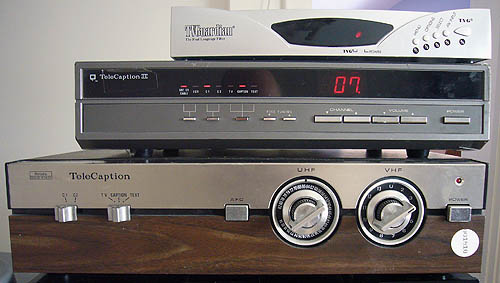T minus 11 days to ATypI Brighton 2007: Captioning
Here we have nearly 30 years’ worth of television caption decoders.

Let’s go from bottom to top, like geological strata.
-
The original TeleCaption decoder, backformed into the name “TeleCaption 1.” I never had one of these; I was about 15 when they came out circa 1979–1980 and my mother refused to buy one. Note the giant size and the rotary dials. (On the back are VHF/UHF connectors for rabbit ears and a single coaxial jack for output.) Of the same era, it was possible to buy a Sears television with a decoder built in (a good 12 years ahead of its time), and those machines, like current television sets, had access to the colour guns and could produce colour captioning. (Or, more likely, colour Text channels, at that time used to list captioned programming. I saw that colour usage myself.)
I bought this one offa eBay in 2003. It had been hacked by the previous owner to include a single RF cable for video and a male earphone jack – only marginally more useful than the original connectors. And, after a great deal of coaxing yesterday, I got the fucker to work on 21st-century equipment. Not very well or reliably, and with lots of snow on the screen, but I got ’er working. And I’ve got pictures to prove it.
-
The TeleCaption II, released circa 1986. I bought one of these as soon as I could put the money together upon arriving in Toronto. For the first time ever, I had captioning on demand (i.e., all the time). What we would now call the form factor of this machine misled many visitors to think it was a VCR. It had a wider range of input and output jacks, including a useful open-caption-out feature. Sears dumped its faulty units on Canada; ours didn’t work with videotapes encoded with Macrovision copy protection. And it couldn’t handle stereo audio, meaning you couldn’t watch captioning and audio description on SAP simultaneously without jiggery-pokery.
The TC IIs included new technical features, like transparent spaces that finally made it possible to centre a line of text, and an antialiased font, albeit still without descenders. (Yes.)
-
Not shown: Built-in decoders, required by U.S. law since 1993. We get the same TV sets, though I did see a single Samsung television exactly once that had no captioning. Caption decoding has now been reduced from a box the size of an early Betamax to half a chip, since decoding is usually on the same chip that displays channels and menus (partly explaining why you can never have both at once).
-
At the top, the TVGuardian, “The Foul Language Filter®.” Yes, it reads caption text and substitutes nice words for swear words. (Ostensibly.) It’s got a pass-through mode in which it functions like a real decoder, or rather like a real decoder that’s busted and a total piece of shit.
I have specifically opted not to buy a few other outdated decoder models – the TeleCaption 3000 and 4000, the MyCap Jr. – because three relics of the past are quite enough.
You won’t believe the differences in typography among all the decoders mentioned.